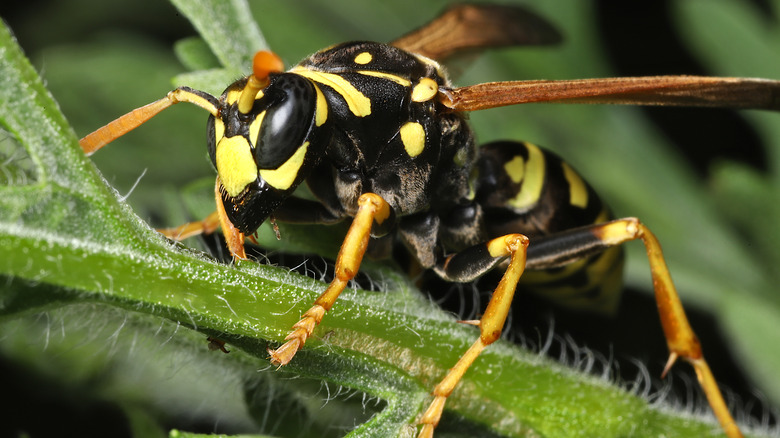The Common Tree Pest That's Attracting Pesky Wasps To Your Yard
A few wasps in your yard are hardly a cause for concern. Yet, if you've noticed even more of them starting to hang around certain trees in your backyard, it could be a sign of a different pest issue entirely. Some species of wasps are attracted to trees infested with aphids, which are tiny insects that attack a variety of plants. However, they typically only do minimal damage to older trees. Different species of aphids may prefer certain types, but they are known to go after pines, aspens, poplars, willows, and elms. Though some trees may experience aphid infestations more often, these pests will go after pretty much any plant they can find, feeding on the sap.
Check the trees where you've seen wasps buzzing around to look for aphids, inspecting the bottoms of young leaves and branches. This will help you ascertain if the wasps are being attracted by another pest. If you find soft-bodied bugs that are about ¹⁄₁₆ to ⅛-inch long, you're likely dealing with aphids. By eliminating these tiny pests, you can keep wasps out of your yard and garden.
Why wasps are attracted to trees with aphids
It may seem strange that tiny bugs feeding on your trees could be attracting wasps, but it's because of a substance the aphids create. These garden pests leave a secretion behind, known as honeydew, that is sticky and sweet. This viscous substance gets all over the branches and leaves of your tree, and may fall onto whatever lies below the canopy, such as your patio or a backyard play set. Unfortunately, the aphid's honeydew attracts a variety of other insects, including wasps, yellowjackets, flies, ants, and even honeybees, that are seeking a source of food.
While there are also parasitic wasps that like to go after aphids themselves, these are very small. They'll lay their eggs inside aphids, killing them, but they won't go after the wasps pestering your yard. It is very likely that wasps are swarming your infested tree due to all the honeydew covering the plant, so to shoo away the wasps, you'll need to get rid of the aphids.
Eliminating pesky aphids from your trees
It's hard to notice aphids because you cannot always see their damage, but in large numbers, these pests may cause the leaves of your tree to turn yellow and curl. The more aphids that are in your trees, the more likely they are to start problems, making more honeydew and inviting wasps to frequent your yard. Additionally, these pests might find their way to more susceptible plants, like the ones growing in your garden. One simple way to easily get rid of pesky aphids is to simply spray your tree with water. Using a hose with a powerful jet setting, you can blast these bugs right off your tree, and the force will likely kill them.
Other insects, such as parasitic wasps, lacewings, and ladybugs, may help control aphid populations. However, a quicker option to eliminate them is to spray the affected branches and leaves of your tree with water and a little bit of dish soap, aiming to cover the aphids' bodies. This should be done every few days for a couple of weeks. You could also try wetting a rag with soapy water and gently wiping it onto the leaves and branches. Once the aphids are gone, the wasps should look for food elsewhere.


